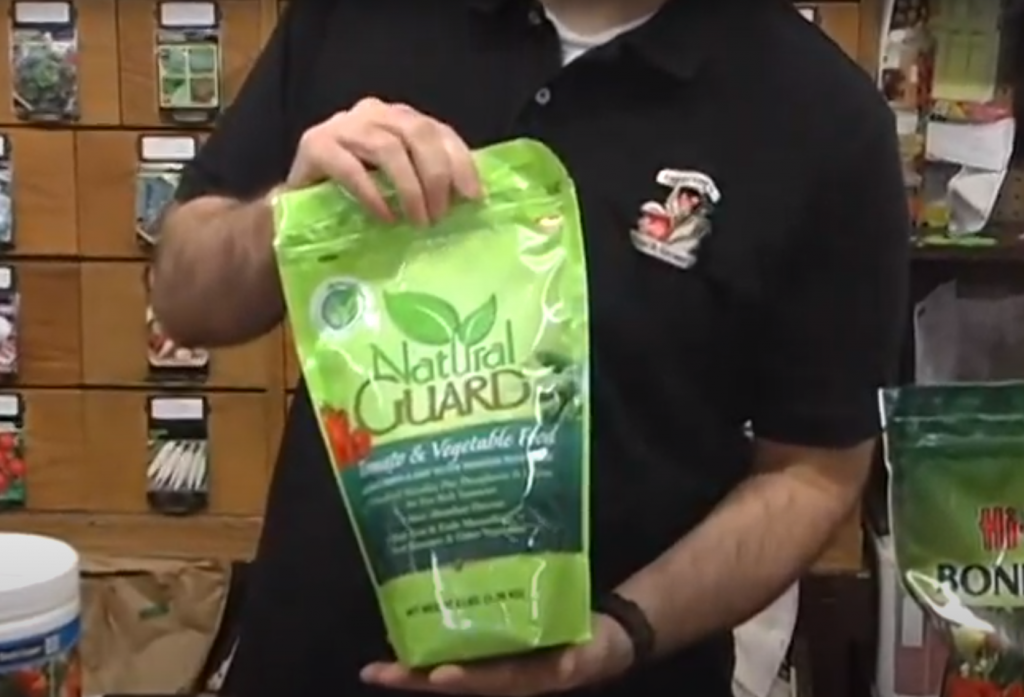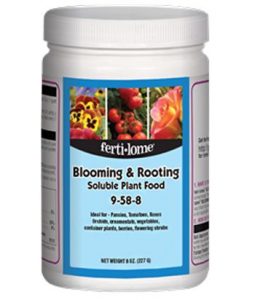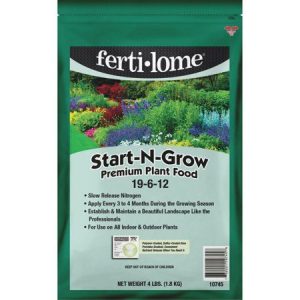What Garden Fertilizer To Use

A lot of times gardeners purchase fertilizer and they don’t know what it does. Maybe it’s a well-advertised, nationally known brand or because it’s on sale at the grocery store. There’s a lot of reasons why we buy different fertilizers and one for the lawn, one for our garden, maybe one for our flowers. But what do the numbers on the fertilizers mean and how all those different fertilizers work?
Nitrogen Phosphorus Potassium
I’m going to show you how to choose the right fertilizer for the plants that you are trying to fertilize. For example, Natural Garden Tomato & Vegetable Food is one of my all-time favorite fertilizers. It is an all-natural organic fertilizer has a lot of different ingredients in it. The analysis on the back is a 4,4,5.
Every fertilizer will have a guaranteed analysis right on the bag or the container.
Nitrogen (N)
The first number is nitrogen. Nitrogen encourages growth. Lawn loves nitrogen. Corn loves nitrogen. Pretty much all your plants need nitrogen to encourage growth to green the plants up and to keep them healthy. The second number, the four in the middle, is phosphorus.
Phosphorus is great for root development, flower production, and fruit production. Phosphorus encourages a lot of fruit development on our vegetables like tomatoes, squashes, melons, and cucumbers. We will get more flowers from our plants. And whether it’s perennials or annuals, the phosphorus encourages more flowering and also encourages root development.
Phosphorus (P)
Phosphorus is very important for your crops, like potatoes, carrots, beets, radishes, anything that develops a root system. It’s essential for all kinds of plants because all plants have root systems and in many cases they all produce flowers and they’ll produce seeds at some point. Phosphorous is critical , especially for vegetables.
Potassium (K)
The last number is potassium. The best way to think of potassium is similar to multivitamins for your plants. It helps the plants absorb up water, and utilize that water better. It also helps with translocation and disperses that water and nutrient through the plants. Finally, it helps plants become more disease resistant, more insect resistant, and more drought-tolerant. Potassium is very, very important in fertilizer.
Nitrogen, phosphorus, and potassium are macronutrients. And that’s what the plants need the most of.
Micronutrients
Lastly, you have the micronutrients. Iron, manganese, boron, copper, and zinc. And those all are essential for the plants, but in much, much smaller quantities. That’s why they’re called micronutrients.
Nitrogen, phosphorus, and potassium are macronutrients. That’s what the plants need the most. The best way to remember this combination is nitrogen makes plants grow up. Phosphorous helps with root development and flower production, fruit production. And potassium is a kind of all-around “multivitamin”.
Fertilizers
So now we know what the nutrients are, We have got a lot of different types of fertilizer we can choose. We have water-soluble fertilizers like Miracle-Gro, but our favorite is the Ferti-Lome Blooming and Rooting. As you can see, the analysis on this one is 9-58-8 (very high phosphorus). It’s great for flowering plants, it’s great for fruiting vegetables. It’s great for fruit development. So that’s what that’s why it’s called blooming and rooting because it encourages flowers and encourages fruit and encourages fruit development.
This is a water-soluble fertilizer. When you mix up water-soluble fertilizers in water, they don’t last very long, usually four to seven days. Whether using Miracle-Gro or Ferti-lome Blooming and Rooting, they usually don’t last very long. The plants pick them up and use them very quickly.
Ferti-lome Tomato and Vegetable
If you shift to a granulated fertilizer like the Feri-lome Tomato and Vegetable food, this is a 7-22-8 fertilizer. Again, higher phosphorus. That’s what most of your vegetables are going to want. This is granulated fertilizer breaks down more gradually over a 6 to 10 week period. Your granulated fertilizers are much slower than water-soluble products.
The best slow-release fertilizers are Start and Grow or Garden Cote 6. Both of these are slow-release fertilizers and will provide longer-lasting nutrition for your plants. They break down very gradually over a much longer period ( 4 to 6 months).
Synthetic Vs Organic Fertilizers
Organic fertilizers work very similarly to synthetic fertilizers, but they break down much slower and over a longer period. They release their nutrient much more gradually. Usually, the analysis of an organic product is lower than a synthetic fertilizer, but that doesn’t mean that there’s not a lot of nutrient content in organic fertilizer. They just work differently.
Be aware when you’re selecting a fertilizer, what the needs of your plants are. If they want a lot of nitrogen like grass or white corn, you don’t want a blooming and rooting fertilizer form. If it’s a vegetable or a flower, you usually want higher phosphorus. You want something that’s going to encourage some flower development and some development as well. Many different fertilizers to choose from, many different options, know what your plants want, and pick the right fertilizer to keep them happy.





